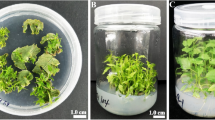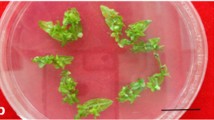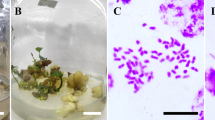Abstract
The present study develops a protocol for tetraploids of multiple genotypes induced from in vitro leaf explants of diploid full-sib progeny [(P. pseudo-simonii × P. nigra ‘Zheyin3#’) × (P. × beijingensis)] after a colchicine treatment. Leaf explants from a ten genotypes full-sib progeny were cultured in MS basal medium containing with 1.78 μM BA and 0.27 μM NAA for 4, 5, and 6 days and transferred to the same liquid MS medium containing different concentrations of colchicine (50, 75, or 100 μM) for 2, 3, and 4 days, respectively. The results indicate that preculture duration, colchicine concentration, and exposure time had significative impacts in tetraploid induction rate but no significant correlation with the genotype. The feasible protocol involves treating a leaf explants pre-culture for 5 days followed by their transfer to liquid MS with 75 μM colchicine for 3 days, for most genotypes of full-sib progeny which could regenerate from leaf explants in the shoot regeneration medium. Tetraploid plantlets are identified using flow cytometric analysis and further confirmed after chromosome counts. Size and frequency of leaf stomata was significantly distinguish the tetraploid from the diploid plants.





Similar content being viewed by others
Abbreviations
- MS:
-
Murashige and Skoog (1962)
- BA:
-
6-Benzyladenine
- NAA:
-
1-Naphthaleneacetic acid
- IBA:
-
Indole butyric acid
- DAPI:
-
4,6-Diamidino-2-phenylindole
- MOPS:
-
4-Morpholinepropane sulfonate
References
Barchet GL, Dauwe R, Guy RD, Schroeder WR, Soolanayakanahally RY, Campbell MM, Mansfield SD (2014) Investigating the drought-stress response of hybrid poplar genotypes by metabolite profiling. Tree Physiol 34:1203–1219
Bradshaw HD, Stettler RF (1995) Molecular genetics of growth and development in populus. IV. Mapping QTLs with large effects on growth, form, and phenology traits in a forest tree. Genetics 139:963–973
Bradshaw HD, Ceulemans R, Davis J, Stettler R (2000) Emerging model systems in plant biology: poplar (Populus) as a model forest tree. J Plant Growth Regul 19:306–313
Cai X, Kang XY (2011) In vitro tetraploid induction from leaf explants of Populus pseudo-simonii Kitag. Plant Cell Rep 30:1771–1778
Chen ZH, Mao QS (2001) On the properties of triploid Chinese white poplar and its relation with pulp and paper making. China Pulp Pap Ind 21:17–20
Cheng S, Zhu X, Liao T, Li Y, Yao P, Suo Y, Kang X (2015) Gene expression differences between high-growth Populus allotriploids and their diploid parents. Forests 6:839–857
Comai L (2005) The advantages and disadvantages of being polyploid. Nat Rev Genet 6:836–846
De Carvalho JFRP, De Carvalho CRDP, Otoni WC (2005) In vitro induction of polyploidy in annatto (Bixa orellana). Plant Cell, Tissue Organ Cult 80:69–75
Dermen H, Henry FB (1944) A general cytohistological study of colchicine polyploidy in Cranberry. Am J Bot 31:451–463
Dhooghe E, Laere KV, Eeckhaut T, Leus L, Huylenbroeck JV (2010) Mitotic chromosome doubling of plant tissues in vitro. Plant Cell, Tissue Organ Cult 104:359–373
Dong CB, Mao JF, Suo YJ, Shi L, Wang J, Zhang PD, Kang XY (2014) A strategy for characterization of persistent heteroduplex DNA in higher plants. Plant J 80:282–291
Eckenwalder JE (1996) Systematics and evolution of Populus. Biol Populus Implic Manag Conserv 1:7–32
Einspahr DW (1984) Production and utilization of triploid hybrid aspen. Iowa State J Res 58:401–409
Ewald D, Ulrich K, Naujoks G, Schröder MB (2009) Induction of tetraploid poplar and black locust plants using colchicine: chloroplast number as an early marker for selecting polyploids in vitro. Plant Cell, Tissue Organ Cult 99:353–357
FAO (2008) Synthesis of country progress reports. Food and Agriculture Organization of the United Nations: the 23rd session of the International Poplar Commission, Beijing
FAO (2012) Synthesis of country progress reports. Food and Agriculture Organization of the United Nations: the 24rd session of the International Poplar Commission, Dehradun
Galbraith DW, Harkins KR, Maddox JM, Ayres NM, Sharma DP, Firoozabady E (1983) Rapid flow cytometric analysis of the cell cycle in intact plant tissues. Science 220:1049–1051
Gilbert SK, Patterson FL (1965) Colchicine induced mutants in Decatur barley. Crop Sci 5:44–47
Gu XF, Yang AF, Meng H, Zhang JR (2005) In vitro induction of tetraploid plants from diploid Zizyphus jujube Mill. Cv. Zhanhua. Plant Cell Rep 24:671–676
Huang Z, Xu C, Li Y, Wang P, Li Y, Kang X (2015) Induction of somatic embryogenesis by anther-derived callus culture and plantlet ploidy determination in poplar (Populus × beijingensis). Plant Cell, Tissue Organ Cult 120:949–959
Jiao Y, Wickett NJ, Ayyampalayam S, Chanderbali AS, Landherr L, Ralph PE, Leebens-Mack J (2011) Ancestral polyploidy in seed plants and angiosperms. Nature 473:97–100
Johnsson H (1945) The triploid progeny of the cross diploid × tetraploid Populus tremula. Hereditas 31:411–440
Kang X, Zhu Z, Zhang Z (1999) Suitable period of high temperature treatment of 2n pollen of Populus tomentosa × P. bolleana. J Beijing For Univ 22:1–4
Li YH, Kang XY, Wang SD, Zhang ZH, Chen HW (2008) Triploid induction in Populus alba × P. glandulosaby chromosome doubling of female gametes. Silvae Genetica 57:37–40
Li Y, Zhen H, Wang PQ, Li Y, Kang XY (2014) Establishment of leaf regeneration system for hybrids of Populus cathayana Rehd. J Nucl Agric Sci 28:0978–0984
Liu G, Li Z, Bao M (2007) Colchicine-induced chromosome doubling in Platanus acerifolia and its effect on plant morphology. Euphytica 157:145–154
Lu M, Zhang P, Wang J, Kang X, Wu J, Wang X, Chen Y (2014) Induction of tetraploidy using high temperature exposure during the first zygote division in Populus adenopoda Maxim. Plant Growth Regul 72:279–287
Luckett D (1989) Colchicine mutagenesis is associated with substantial heritable variation in cotton. Euphytica 42:177–182
Mashkina OS, Burdaeva LM, Belozerova MM, Vyunova LN (1989a) Ethod of obtaining diploid pollen of woody species. Lesoved 1:19–25
Mashkina OS, Burdaeva LM, Vyunova LN (1989b) Experimental mutagenesis and polyploidy in breeding forest trees. Lesnaya genetika, selektsiya i fiziologiya drevesnykh rasteniĭ, Voronezh, 25-30 sentyabrya, 1989: Materialy Mezhdunarodnogo simpoziuma, pp 136–137. http://www.cabdirect.org/abstracts/19901696883.html
Mergen F, Lester DT (1971) Colchicine induced polyploidy in Abies. For Sci 7:314–319
Mohrdiek O, Melchior GH (1976) Combined hybrid and polyploid breeding as a promising method for poplars of the section Leuce: comparison of diploid and triploid grey poplars [Populus canescens] of the same progenies. Holzzucht 30:7–10
Mu JJ (2013) Transcriptomic Analysis of Growth and Reproductive Changes in Birch (Betula platyphylla) Autotetraploids. Dissertation, Northeast Forestry University
Murashige T, Skoog F (1962) A revised medium for rapid growth and bio assays with tobacco tissue cultures. Physiol Plant 15:473–497
Nilanthi D, Chen XL, Zhao FC, Yang YS, Wu H (2009) Induction of tetraploids from petiole explants through colchicine treatments in Echinacea purpurea L. BioMed Res Int. doi:10.1155/2009/343485
Nilsson-Ehle H (1936) Note regarding the gigas from of Populus tremula found in nature. Hereditas 21:372–382
Seitz FW (1954) The occurrence of triploids after self-pollination of anomalous androgynous flowers of a grey poplar. Zeitschrift für Forstgenetik and Forstpflanzenzüchtung 3:1–6
Sharman BC (1945) Leaf and bud initiation in the Gramineae. Bot Gaz 106:269–289
Tang ZQ, Chen DL, Song ZJ, He YC, Cai DT (2010) In vitro induction and identification of tetraploid plants of Paulownia tomentosa. Plant Cell, Tissue Organ Cult 102:213–220
Tavan M, Mirjalili MH, Karimzadeh G (2015) In vitro polyploidy induction: changes in morphological, anatomical and phytochemical characteristics of Thymus persicus (Lamiaceae). Plant Cell, Tissue Organ Cult 122:573–583
Taylor GAIL (2002) Populus: Arabidopsis for forestry. Do we need a model tree. Ann Bot 90:681–689
Thao NTP, Ureshino K, Miyajima I, Ozaki Y, Okubo H (2003) Induction of tetraploids in ornamental Alocasia through colchicine and oryzalin treatments. Plant Cell, Tissue Organ Cult 72:19–25
Tosca A, Pandolfi R, Citterio S, Fasoli A, Sgorbati S (1995) Determination of flow cytometry of the chromosome doubling capacity of oryzalin and colchicine in gynogenetic haploids of gerbera. Plant Cell Rep 14:455–458
Ulrich K, Ewald D (2014) Breeding triploid aspen and poplar clones for biomass production. Silvae Genet 63:47–58
Van Tuyl JM, Meijer B, Van Diën MP (1992) The use of oryzalin as an alternative for colchicine in in vitro chromosome doubling of Lilium and Nerine. In VI international symposium on flower bulbs, vol 325, pp 625–630
Viehmannová I, Cusimamani EF, Bechyne M, Vyvadilová M, Greplová M (2009) In vitro induction of polyploidy in yacon (Smallanthus sonchifolius). Plant Cell, Tissue Organ Cult 97:21–25
Wahid A, Gelani S, Ashraf M, Foolad MR (2007) Heat tolerance in plants: an overview. Environ Exp Bot 61:199–223
Wan Y, Petolin JF, Widholm JM (1989) Efficient production of doubled haploid plants through colchicine treatment of antherderived maize callus. Theor Appl Genet 77:889–892
Wang XJ, Wu JY, Cheng Y, Liao DZ (2006) Progress on research of improved variety propagation of Populus adenopoda Maxim. Hunan For Sci Technol 5:28
Wang J, Kang XY, Shi L, Lu M, Yang J (2010) Tetraploid induction of Populus hybrid in section Tacamahaca through zygotic chromosome doubling with physical and chemical treatments. J Beijing For Univ 32:63–66
Weisgerber H (1980) 25 years of forest tree breeding in Hesse. Allgemeine Forstzeitschrift 26:665–712
Xie X, Agüero CB, Wang Y, Walker MA (2015) In vitro induction of tetraploids in Vitis × Muscadinia hybrids. Plant Cell, Tissue Organ Cult 122:675–683
Yang X, Cao Z, An L, Wang Y, Fang XW (2006) In vitro tetraploid induction via colchicine treatment from diploid somatic embryos in grapevine (Vitis vinifera L.). Euphytica 152:217–224
Yao C, Pu J (1998) Timber characteristics and pulp properties of the triploid of populus tomentosa. J Beijing For Univ 5:18–21
Zhang S, Qi L, Chen C, Li X, Song W, Chen R et al (2004) A report of triploid Populus of the section Aigeiros. Silvae Genet 53:69–75
Zhang Z, Kang X, Zhang P, Li Y, Wang J (2007) Incidence and molecular markers of 2n pollen in Populus tomentosa Carr. Euphytica 154:145–152. doi:10.1007/s10681-006-9280-7
Zhang Z, Dai H, Xiao M, Liu X (2008) In vitro induction of tetraploids in Phlox subulata L. Euphytica 159:59–65
Zhang J, Wei Z, Li D, Li B (2009) Using SSR markers to study the mechanism of 2n pollen formation in Populus × euramericana (Dode) Guinier and P. popularis. Ann For Sci 66:53–62
Zhang Q, Luo F, Liu L, Guo F (2010) In vitro induction of tetraploids in crape myrtle (Lagerstroemia indica L.). Plant Cell, Tissue Organ Cult 101:41–47
Zhu Z (2006) Genetic improvement of Populus tomentosa. Chinese Forestry Press, Beijing
Zhu Z, Lin HB, Kang X (1995) Studies on allotriploid breeding of Populus tomentosa B301 clones. Sci Silvae Sin 31:499–505
Zhu Z, Kang X, Zhang Z (1998) Studies on selection of natural triploid of Populus tomentosa. Sci Silvae Sin 34:22–31
Acknowledgments
This research was supported by a Grant from National Natural Science Foundation of China for Molecular basis of the vegetative growth advantage in allotriploid poplar (31530012), Supported by a Grant from the Special Fund for Forest Scientific Research in the Public Welfare (201404113) and Supported by Program for Changjiang Scholars and Innovative Research Team in University (IRT13047).
Author information
Authors and Affiliations
Corresponding author
Ethics declarations
Conflict of interest
The authors declare that they have no conflict of interest.
Rights and permissions
About this article
Cite this article
Xu, C., Huang, Z., Liao, T. et al. In vitro tetraploid plants regeneration from leaf explants of multiple genotypes in Populus . Plant Cell Tiss Organ Cult 125, 1–9 (2016). https://doi.org/10.1007/s11240-015-0922-0
Received:
Accepted:
Published:
Issue Date:
DOI: https://doi.org/10.1007/s11240-015-0922-0




